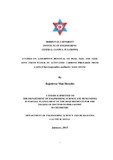Please use this identifier to cite or link to this item:
http://archive.nnl.gov.np:8080/handle/123456789/388Full metadata record
| DC Field | Value | Language |
|---|---|---|
| dc.contributor.author | Shrestha, Rajeshwar Man | |
| dc.date.accessioned | 2017-11-24T06:18:17Z | |
| dc.date.accessioned | 2020-08-21T08:05:58Z | - |
| dc.date.available | 2017-11-24T06:18:17Z | |
| dc.date.available | 2020-08-21T08:05:58Z | - |
| dc.date.issued | 2017-11-24 | |
| dc.identifier.uri | http://103.69.125.248:8080/xmlui/handle/123456789/388 | - |
| dc.description | A thesis submitted to the Department of Engineering Science and Humanities in partial fulfillment of the requirements for the Degree of Doctor of Philosophy in Chemistry, Department of Engineering Science and Humanities, Lalitpur, Nepal, 2015 | en_US |
| dc.description.abstract | Lignocellulosic materials such as coconut shell and fruit stones were abundantly used for the preparation of activated carbon because of their availability at a low price, hardness and high density. In the present study, Lapsi (Choerospondias axillaris) seed stone, a waste product of Lapsi, an indigenous plant of Nepal was used as the precursor for the preparation of activated carbon. The percentage of carbon, hydrogen, nitrogen and sulphur and proximate analysis of Lapsi seed stone powder were recorded. The percentage of carbon, hydrogen, nitrogen, oxygen and sulphur was found to be 49.98 %, 5.07 %, 1.47 %, 43.47 and 0.01 % respectively. In proximate analysis the moisture content, ash content, volatile matter and fixed carbon content were determined and found to be 0.29 %, 2.94%, 63.97% and 32.8 respectively. A series of activated carbons was prepared by chemical carbonization and thermal carbonization of the precursor. In chemical carbonization Lapsi seed stone powder (particle size < 300 μm) was carbonized with concentrated sulphuric acid and a mixture of concentrated sulphuric acid and concentrated nitric acid. The resultant carbons were characterized by FTIR, Boehm titration and SEM. The use of nitric acid induced more oxygenated surface functional groups with higher adsorption capacity for Pb(II) and Ni(II) ions. The effect of pH, contact time and adsorbent dose was studied by batch adsorption technique. The optimum pH for adsorption of Pb (II) and Ni(II) was found to be 5 .The adsorption equilibrium data was analyzed by Langmuir and Freundlich adsorption isotherms. Langmuir isotherm was found to be better fit than Freundlich adsorption isotherm. Adsorption kinetic data followed pseudo second order kinetics. Negative values of Gibbs free energy for adsorption (ΔGo) show the spontaneity of the adsorption of the metal ions. In thermal carbonization Lapsi seed stone powder was carbonized in horizontal tubular furnace with different amount of phosphoric acid as activating agent. Thermogravimetric analysis (TGA) of Lapsi seed stone was carried out to determine optimum condition for carbonization. The effect of carbonization time, temperature and different ratio of the precursor and phosphoric acid were also studied. The best activated carbon with high specific surface area was obtained when the ratio of lignocellulosic material and phosphoric acid was 1:1 and the temperature of carbonization was found to be 400 oC with carbonization time 4 hours. The activated carbons prepared were characterized by determination of iodine number and methylene blue number. Surface morphology of activated carbon (AC) was accessed by SEM and surface functional groups were analyzed by FTIR. Surface area and average pore diameter of activated carbons was determined by N2 adsorption/ desorption using BET isotherm. XRD analysis was carried to know the extent of amorphous structure of activated carbon. The Boehm titration was carried out to estimate acidic surface functional groups. The adsorption of Pb(II), Cd(II) and Ni(II) from aqueous solutions by activated carbon was investigated by batch adsorption method. The effect of various parameters like pH, adsorbent dose and contact time on the removal of Pb(II) , Cd(II) and Ni(II) was studied. Optimum pH for the adsorption of Pb(II), Ni(II) and Cd(II) was found to be at 5 and 6 respectively. The optimum adsorbent dosage for the adsorption of Pb(II), Ni(II) and Cd(II) was found to be 2g/L.The time required to reach equilibrium is about 180 minutes. The adsorption equilibrium data was analyzed by Langmuir and Freundlich adsorption isotherms. The Langmuir isotherm was bette fit than Freundlich one with higher values of coefficient of determination (R2 = 0.990, 0.998 and 0.997 for Pb(II) Cd(II) and Ni(II) respectively). Monolayer adsorption capacity of Pb (II), Ni (II) and Cd(II) are 131.0 mg/g, 37.0 mg/g and 28.0 mg/g respectively. The adsorption kinetic data were analyzed by pseudo first and second order kinetics. The kinetic data were better followed pseudo second order kinetics. The values of Gibbs free energy constant (ΔGº) are – 26.6 kJmol-1 for Pb(II), -24.7 kJmol-1 for Cd(II) and -25.5 kJmol-1 for Ni(II).The –ve values of the Gibbs free energy indicated that the adsorption process is spontaneous. | en_US |
| dc.language.iso | en | en_US |
| dc.subject | Activated carbons | en_US |
| dc.subject | Lapsi seed stone | en_US |
| dc.subject | Heavy metals | en_US |
| dc.subject | Chemical activation | en_US |
| dc.subject | Adsorption capacity | en_US |
| dc.subject | Adsorption isotherms | en_US |
| dc.subject | Adsorption kinetics | en_US |
| dc.subject | Adsorption | en_US |
| dc.title | Studies on adsorptive removal of Pb(II), Ni(II) and Cd(II) Ions from water by activated carbons prepared from Lapsi (Choerospondias axillaris) seed stone | en_US |
| dc.type | Thesis | en_US |
| Appears in Collections: | 600 Technology (Applied sciences) | |
Files in This Item:
| File | Description | Size | Format | |
|---|---|---|---|---|
| Thesis -Final -Shrawan-12.pdf | 2.76 MB | Adobe PDF |  View/Open |
Items in DSpace are protected by copyright, with all rights reserved, unless otherwise indicated.